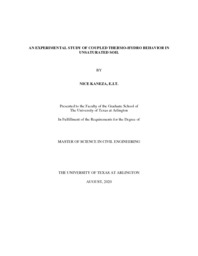
ATTENTION: The works hosted here are being migrated to a new repository that will consolidate resources, improve discoverability, and better show UTA's research impact on the global community. We will update authors as the migration progresses. Please see MavMatrix for more information.
Show simple item record
| dc.contributor.advisor | Yu, Xinbao | |
| dc.creator | Kaneza, Nice | |
| dc.date.accessioned | 2022-01-20T18:09:27Z | |
| dc.date.available | 2022-01-20T18:09:27Z | |
| dc.date.created | 2020-08 | |
| dc.date.issued | 2020-08-25 | |
| dc.date.submitted | August 2020 | |
| dc.identifier.uri | http://hdl.handle.net/10106/30168 | |
| dc.description.abstract | Understanding unsaturated soils in response to the impact of temperature will better predict the performance of geo-structures that extract and inject underground heat. Previous studies have shown that heat and water in unsaturated soil affect the movement of each other and that thermal gradients are responsible for the migration of water and thermal properties. Therefore, it is essential to study the coupling behavior of thermal and hydraulic (TH) processes to analyze the distribution of moisture and thermal properties of unsaturated soil. These processes are transient and difficult to examine in the field. In addition, there is a lack of laboratory testing apparatus to measure the coupled TH processes under controlled true one-dimensional heating condition. This thesis presents a modified soil testing cell, which was previously developed for agricultural applications and showed well-controlled one-dimensional heating in the soil. This device was used to conduct laboratory experiments to assess the coupling behavior of TH processes of unsaturated soil.
Two sands were selected for the experiments and compacted in the soil testing cell, equipped with thermocouples, time domain reflectometry sensors, and thermo-time domain reflectometry sensors. Different temperature boundary conditions were then imposed on the soil testing cell to create thermal gradients in the unsaturated soil. The measuring devices recorded the temperature variations and waveforms of the apparent dielectric constant (Ka) and bulk electrical conductivity (ECb) that were used to calculate the gravimetric water content (ω) of soil using the Topp’s equation, One Step method, and a and b method. It was observed that ambient temperature interfered with the temperatures imposed by the heat exchangers of the soil testing cell, as steady-state temperature distributions displayed a concave downward temperature profile for the tested unsaturated soil, due to the lack of proper insulation and gravity for the ASTM fine sand. This modified soil cell had proved, however, the ability to maintain one-dimensional heat transfer in previous studies presented herein. It was also noticed that among the two selected sands, the Hazy Meadow Park soil, containing the greatest amount of fine particles, with a low initial gravimetric water content and subjected to a moderate thermal gradient, more properly displayed the phenomenon of coupled TH processes in unsaturated soil. | |
| dc.format.mimetype | application/pdf | |
| dc.language.iso | en_US | |
| dc.subject | Coupled thermo-hydro behavior | |
| dc.title | AN EXPERIMENTAL STUDY OF COUPLED THERMO-HYDRO BEHAVIOR IN UNSATURATED SOIL | |
| dc.type | Thesis | |
| dc.degree.department | Civil Engineering | |
| dc.degree.name | Master of Science in Civil Engineering | |
| dc.date.updated | 2022-01-20T18:09:27Z | |
| thesis.degree.department | Civil Engineering | |
| thesis.degree.grantor | The University of Texas at Arlington | |
| thesis.degree.level | Masters | |
| thesis.degree.name | Master of Science in Civil Engineering | |
| dc.type.material | text | |
| dc.creator.orcid | 0000-0002-6036-3546 | |
Files in this item
- Name:
- KANEZA-THESIS-2020.pdf
- Size:
- 3.829Mb
- Format:
- PDF
This item appears in the following Collection(s)
Show simple item record


